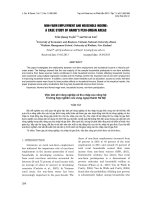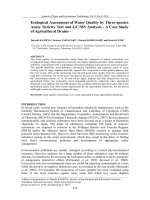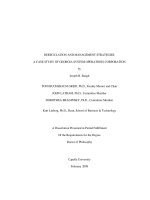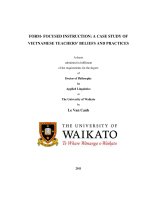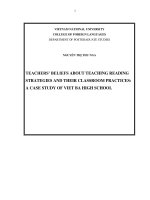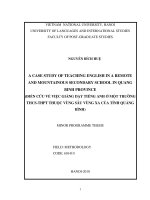Teachers’ beliefs about teaching reading strategies and their classroom practices- a case study of viet ba high school
Bạn đang xem bản rút gọn của tài liệu. Xem và tải ngay bản đầy đủ của tài liệu tại đây (402.48 KB, 62 trang )
1
VIETNAM NATIONAL UNIVERSITY
COLLEGE OF FOREIGN LANGUAGES
DEPARTMENT OF POSTGRADUATE STUDIES
NGUYỄN THỊ THU NGA
TEACHERS’ BELIEFS ABOUT TEACHING READING
STRATEGIES AND THEIR CLASSROOM PRACTICES:
A CASE STUDY OF VIET BA HIGH SCHOOL
2
CHAPTER 1
INTRODUCTION
1.1. Rationale:
English has been widely used in many areas such as politics, economics, tourism,
electronics, telecommunication, culture and science and technology. English is not only a
means of but also a key to accessing the latest achievements of science and technology.
Therefore, it is necessary for many Vietnamese to have a good command of English to
satisfy the growing needs in a developing country like Viet Nam.
Reading is an essential skill for English as a second or foreign language (ESL/EFL). For
many, reading is the most important skill to master. With strengthened reading skills,
ESL/ EFL readers will make greater progress and attain greater development in all
academic areas.
In Vietnam, English is taught and learned in a non – native environment so reading is not
only an important means to gain knowledge but also a means by which further study
takes place. According to Carrell (1984:1): ―for many students, reading is by far the most
important of the four macro skills, particularly in English as a second or a foreign
language‖. This is also true to the students at Viet Ba High School since the reading skill
offers them a wide range of interesting information as well as a variety of language
expressions and structures which are of great usefulness for developing other language
skills.
When dealing with a reading lesson, students often experience the lack of reading
strategies which are essential for them to overcome the challenges in the classroom.
Research into reading has found that effective readers are aware of the strategies they use
and that they use strategies flexibly and efficiently (Garner, 1987; Presley, Beard EL,
Dinary & Brown, 1992). Researchers believed that these strategies could be taught to
ineffective language learners so that they can become more successful in language
3
learning. As Oxford (1990:1) states, language learning strategies " are especially
important for language learning because they are tools for active, self-directed
movement, which is essential for developing communicative competence." Therefore,
teachers should consider teaching students effective reading strategies, especially
showing them how to utilize the skills and knowledge that they bring from their first
language in order to cope with reading in the second language.
Besides developing reading proficiency for students, teachers who train students to use
reading strategies can also help them become autonomous language learners. As a result,
teaching students learning strategies is an important duty of the language teachers since
learning strategies can help students monitor and take charge of their own learning.
Helping students understand good language learning strategies and training them to
develop and use such good language learning strategies can be considered to be the
appreciated characteristics of a good language teacher (Lessard-Clouston, 1997:3).
Research into teachers‘ beliefs generally show that teachers have their own beliefs /
cognitions / theories about teaching and learning which might have been influenced by
their training, work experience and so on. Teachers are not passive recipients of theories
but do construct their own theories.
For all of these reasons, it would be necessary to have an investigation into teachers‘
beliefs about teaching reading strategies and their classroom practice. By doing so, we
could recognize the relationship between teacher beliefs and practice and student
learning. Moreover, teachers‘ beliefs are related to student learning through some event
or sequences of events, mediated by the teachers that happen in the classroom. These
events might be said to "cause" student learning in the sense that the events in the
classroom lead, in the case of effective teaching, to student learning.
It is hoped that this study will reveal issues concerning teaching reading strategies and
provide classroom English teachers with an in – depth understanding about reading
strategies to make decisions on how and what they should do to keep their students much
more involved in the reading process.
4
1.2. Aims of the study:
This study aims at exploring teachers‘ beliefs about teaching reading strategies and
reading strategies instruction by teachers at Viet Ba High School with a view to giving
some recommendations on how to instruct reading strategies in reading classrooms
effectively. The specific aims of the research are as follows:
To find out the teacher‘s beliefs about teaching reading strategies at Viet Ba High
School.
To examine the extent to which their beliefs are reflected in their reading classes /
classroom practices
To give recommendations for teaching reading strategies so as to improve
students‘ ability of reading in English
1.3. Scope of the study:
Learners‘ success or failure in acquiring a language can be affected by many intertwining
factors. Among these factors, teaching reading strategies should be taken into
consideration. However, this study only focuses on the teaching of reading strategies by
teachers at Viet Ba High School and some implications for handling these strategies in
their classrooms.
1.4. Significance of the study:
The study highlights the important role of teachers‘ beliefs and the important role of
teaching reading strategies to students in general and students at Viet Ba High School in
particular. More importantly, it offers the theoretical basis for the application of reading
techniques in the classroom.
5
1.5. Research methods used in the study:
To achieve the aims mentioned above, the study employed interview and class
observation to collect information on teachers‘ beliefs about teaching reading strategies
and their classroom practice.
1.6. Organization of the thesis:
The thesis is divided into five chapters.
Chapter 1 is the Introduction which presents the rationale for conducting the study, the
scope of the study, its significance, aims as well as research methods.
Chapter 2 provides a theoretical framework for the study, including definitions and types
of reading, issues in teaching reading skills and reading strategies, teachers‘ beliefs and
their classroom practices.
Chapter 3 reports the methodology used in the research including research questions,
participants, instruments and the procedures for data collection and analysis.
Chapter 4 reports and discusses the major findings.
Chapter 5 is the last part of the study, ―Conclusion‖ that summarizes what is addressed in
the study, points out the limitations, draws pedagogical implications and provides some
suggestions for further study.
6
CHAPTER 2
LITERATURE REVIEW
This chapter reviews theories related to reading and reading activities in general and
reading strategies in particular. It also reviews current research on teachers‘ beliefs and
classroom practice and summarizes some studies on teachers‘ beliefs about teaching
reading strategies that have been conducted so far. All of these serve as a basis for an
investigation into teachers‘ beliefs about teaching reading strategies and their classroom
practices which is carried out and presented in the next chapter.
2.1. Reading and reading activities:
2.1.1. Definition and types of reading:
Reading is a completely individual activity which takes place in all different ways from
reading newspapers, magazines, written texts, telephone directories, labels on medicine
bottles, etc. The ability to read is such a natural part of human beings that they seldom try
to define reading. However, there are still different points of views on what reading is.
These views are often grouped under three different reading models named the bottom –
up, the top – down and the interactive ones.
2.1.1.1. Bottom – up model:
According to the bottom – up model, reading was viewed as ― the process of meaning
interpretation‖ in which ―the language is translated from one form of symbolic
representation to another‖ (Nunan, 1991). It was also understood as the process of
recognizing the printed letters and words and building up a meaning from the smallest
textual units at the bottom (letter and words) to larger units at the top (phrases, clauses,
intersentential linkages) (Rivers 1964, 1968; Plaister 1968; Yorio 1971). In other words,
in the bottom – up model, the reader begins with the written text (the bottom) and
constructs meaning from letters, words, phrases and sentences found within, and then
7
processes the text in a linear fashion. Clearly, in the view of this driven model, the reader
seems to play a relatively passive role because the basis of bottom – up processing is the
linguistic knowledge of the reader.
Samuel and Kamil (188: 31) pointed out the shortcomings of these models as follows:
―Because of the lack of feedback loops in the early bottom – up models, it was difficult to account
for sentence – context effects and the role of prior knowledge of text topic as facilitating variables
in word recognition and comprehension‖.
Due to this limitation, the bottom – up view of reading fell into disfavor.
2.1.1.2. Top – down model:
In this model, reading was seen as the process in which readers move from the top, the
higher level of mental stages down to the text itself. This approach emphasizes the
reconstruction of meaning rather than the decoding of form, the interaction between the
reader and the text rather than the graphic forms of the printed pages. The readers proves
his active role in the reading process by bringing to the interaction his/ her available
knowledge of the subject, knowledge of and expectations about how language works,
motivation, interest and attitudes towards the content of the text.
According to Ur (1996: 138) ―reading means reading and understanding‖ and according
to Anderson (1999: 1) ―reading is not a passive process but an active fluent process
which involves the reader and the reading material in building meaning‖. What is more,
meaning of the reading materials does not reside on the printed page, nor it is only in the
head of the reader. A synergy occurs in reading which is the combination of the words on
the printed page with the reader‘s background knowledge and experiences.
Apparently, the strong points of top – down models outnumber those of the bottom – up
as the reader – the center of the reading process – proves his active role. However, for
some researchers, these models still reveal certain shortcomings. Stanovich (1988) stated
that ― the generation of hypotheses would actually be more time – consuming than
decoding‖ and Eskey (1988: 93) believed that ― in making the perfectly valid point that
fluent reading is primarily a cognitive process, they (N.B: researchers who approved top
8
– down models) tend to deemphasize the perceptual and decoding dimensions of that
process‖.
Due to limitations of both bottom – up and top – down models, a new and more insightful
reading process has been proposed under the name of interactive model.
2.1.1.3. Interactive model:
Interactive theorists appreciate the role of prior knowledge and prediction, and at the
same time emphasize the importance of rapid and accurate processing of the actual words
of the text.
According to Hayes (1991: 7) ― in interactive models, different processes are thought to
be responsible for providing information that is shared with other processes. The
information obtained from each type of processing is combined to determine the most
appropriate interpretation of the printed pages‖.
To sum up, the arrival and popularity of interactive models show that interactive models
can maximize the strengths and minimizes the weaknesses of born bottom – up and top –
down models.
2.1.2. Characteristics of an effective reader:
Research has generally shown that an effective reader knows how to use reading
strategies that work for himself / herself. According to Wassman and Rinsky (1993: 5),
an effective reader needs ‗an understanding of the reading process and an understanding
of how to go about reading different types of printed information‘. In this way, a second
or foreign learner can practice techniques that will help to succeed in becoming an
effective reader. Besides, they also point out two necessary ingredients for an effective
reader, i.e. the willingness to change reading habits that limit the learner‘s reading ability
and the willingness to practice. Apart from this, there are other factors helping second or
foreign language readers to become effective:
9
Organize properly for reading and study: this requirement forces the
reader to understand the importance of disciplined study so that they can
appropriately time to devote to reading and study
Improve the concentration: actually concentration is important to learning
in general and learning in particular for the fact that readers need to
comprehend the printed information.
Maintain confidence: confident reading is chiefly the result of preparation.
Without this, readers can‘t become effective readers
2.1.3. Teaching reading skills:
In an article about teaching reading, Bamford and Day (1998: 124 -141) state that around
the world there are at least four distinctive approaches to the teaching of foreign or
second language reading: grammar – translation, comprehension questions, skills and
strategies and extensive reading
Grammar – translation: Under this approach, students may be taught to read texts
written in the foreign language by translating them into the native language. As a
result, meaning is taken at the sentence level with less attention paid to the
meaning of the text as a whole and meaning is constructed via the native
language, not directly from the foreign language
Comprehension questions and language work: This approach focuses on teaching
a textbook containing short passages that demonstrate the use of foreign language
words or points of grammar. These texts, short enough to encourage students to
read them word by word, are followed by comprehension questions and exercises.
Skills and strategies: to follow skills and strategies approach, the teacher has to
prepare for students to read a one or two - page passage from a textbook by
providing or activating any background knowledge needed for comprehension.
This preparation may include pre – teaching vocabulary that appears in the
10
reading passage. Students then read the passage silently while keeping in mind
two or three while reading questions.
Extensive reading: The goal of this is for students to become willing and able
readers in a second or foreign language. Students individually read books and
other materials at their own speed mainly for homework.
2.2. Reading strategies:
2.2.1. Defining strategies:
Learning strategies are defined as ―specific actions, behaviors, steps, or techniques - such
as seeking out conversation partners, or giving oneself encouragement to tackle a difficult
language task - used by students to enhance their own learning‖ (Scarcella & Oxford,
1992: 63). In other words, they are mental a communicative procedure learners use in
order to learn and use a language (Nunan, 1991). When the learner consciously chooses
strategies that fit his or her learning style and the L2 task at hand, these strategies become
a useful toolkit for active, conscious, and purposeful self-regulation of learning.
Language Learning Strategies have been classified by many scholars (Wenden and Rubin
1987; O'Malley et al. 1985; Oxford 1990; Stern 1992; Ellis 1994, etc.). For example,
Rubin (1987) classified language learning strategies as Learning Strategies,
Communication Strategies and Social Strategies. Oxford (1990: 9) divides language
learning strategies into two main classes, direct and indirect. The former consists of
memory, cognitive and compensation strategies while the latter includes metacognitive,
affective and social strategies. However, Oxford‘s classification of learning strategies is
somewhat complicated and confusing as she treats compensation strategies as a direct
type of learning strategies and memory strategies as separate ones from cognitive
strategies.
According to Stern (1992:262-266), there are five main language learning strategies.
These are Management and Planning Strategies, Cognitive Strategies, Communicative -
Experiential Strategies, Interpersonal Strategies, Affective Strategies.
11
The framework that has been most useful and generally accepted is O‘Malley and
Chamot (1990)‘s. In O‘Malley and Chamot‘s framework, three major types of strategies
named as metacognitive, cognitive and social/ affective are distinguished in accordance
with the information processing model, on which their research is based. The subtypes of
these strategies were identifies by O‘Malley and Chamot on the basis of their several
descriptive studies on learning strategies used by second language learners (see Table 1).
Table 1. Learning strategy definition and classification (O’Malley and Chamot, 1990: 119)
Learning strategies
Definition
A. METACOGNITIVE
STRATEGIES
Planning
Advance organizers
Previewing the main ideas and concepts of the material to be
learned, often by skimming the text for the organizing principle
Directed attention
Deciding in advance to attend in general to a learning task and to
ignore irrelevant distracters.
Functional planning
Planning for and rehearing linguistic components necessary to
carry out an upcoming task
Selective attention
Deciding in advance to attend to specific aspects of input, often by
scanning for key words, concepts and/ or linguistic markers
Self – management
Understanding the conditions that help one learn and arranging for
12
the presence of those conditions.
Monitoring
Self – monitoring
Checking one‘s comprehension during listening or reading
checking the accuracy and/or appropriateness of one‘s oral or
written production while it is taking place
Evaluation
Self – evaluation
Checking the outcomes of one‘s own language against a standard
after it has been completed
B.COGNITIVE
STRATEGIES
Resourcing
Using target language reference materials such as dictionaries,
encyclopedias, or textbooks
Repetition
Imitating a language model, including overt practice and silent
rehearsal
Grouping
Classifying words, terminology or concepts according to the
attributes or meaning
Deduction
Applying rules to understand or produce the second language
making up rules based on language analysis
13
Imagery
Using visual images (either mental or actual) to understand or
remember new information
Auditory representation
Planning back in one‘s mind the sound of a word, phrase or
longer language sequence
Key word method
Remember a new word in the second language by: (1) identifying
a familiar word in the first language that sounds like or otherwise
resembles the new word, and (2) generating easily recalled images
of some relationship with the first language homonym and the new
word in the second language.
Elaboration
Relating new information to prior knowledge, relating different
parts of new information to each other, or making meaningful
personal associations with the new information.
Transfer
Using previous linguistic knowledge or prior skills to assist
comprehension or production.
Inferencing
Using available information to guess meaning of new items,
predict outcomes or fill in missing information.
Note taking
Writing down key words or concepts in abbreviated verbal,
graphic or numerical form while listening or reading.
Summarizing
Making a mental, oral or written summary of new information
gained through listening or reading.
14
Recombination
Constructing a meaningful sentence or larger language sequence
by combining known elements in a new way.
Translation
Using the first language as a base for understanding and/or
producing the second language.
C.SOCIAL / AFFECTIVE
STRATEGIES
Question for clarification
Eliciting from a teacher or peer additional explanations,
rephrasing, examples or verification.
Cooperation
Working together with one or more peers to solve a problem, pool
information, check a learning task, model a language activity, or
get feedback on oral or written performance.
Self - talk
Reducing anxiety by using mental techniques that make one feel
competent to do the learning task.
2.2.2. The importance of strategies in the learning process:
Knowledge of strategies is important because if one is conscious of the processes
underlying the learning that s/he is involved in, then the learning will be more effective.
The fact showed that learners who are taught learning strategies are more highly
motivated than those who are not. However, not all learners automatically know which
strategies work best for them. For this reason, explicit strategy training, coupled with
thinking about how one goes about learning, and experimenting with different strategies,
can lead to more effective learning.
15
Oxford (1990: 1) argues that strategies are important for two reasons. In the first place,
strategies ―…are tools for active, self – directed involvement, which is essential for
developing communicative competence‖. Secondly, learners who have developed
appropriate learning strategies have greater self – confidence and learn more effectively.
In her book, she identifies twelve key features of strategies. According to Oxford,
language learning strategies:
contribute to the main goal, communicative competence
allow learners to become more self – directed
expand the role of teachers
support learning both directly and indirectly
2.2.3. Strategies in teaching second language reading:
Reading comprehension strategies are seen as comprehension processes that enable
readers to construct meaning from the printed page most effectively. In other words,
those strategies show how readers tackle a reading task, how they interpret their reading
and what they do when they do not comprehend.
Many researchers have similarities in categorizing reading strategies. For example,
Anderson (1999), Brantmeier (2002), Almasi ( 2003) and Sugirin (1999) emphasized the
role of prior knowledge in reading. Brantmeier (2002) and Brown (1990) introduced
skimming, scanning and guessing as effective strategies in reading. However, there are
some differences in their classification.
For instance, Brantmeier (2002: 1) summarizes reading strategies as follows:
―The strategies may involve skimming, scanning, guessing, recognizing cognates and word
families, reading for meaning, predicting, activating general knowledge, making inferences,
following references, and separating main ideas from supporting ideas‖.
16
Furthermore, reading strategies can consist of evaluating content, such as agreeing or
disagreeing, making an association with prior knowledge or experience, asking and
answering questions, looking at the key words, using sentence structure analysis such as
determining the subject, verb or object of the sentence, skipping and rereading (Almasi,
2003; Sugirin, 1999). Clearly, not all strategies are of equal effectiveness due to the
different types of reading texts and tasks, and reading strategy use by each reader.
Brown (1990: 3) provides strategies that can help students read more quickly and
effectively:
Previewing: reviewing titles, section headings and photo captions to get a sense of
the structure and content of a reading selection.
Predicting: using knowledge of the subject matter to make predictions about
content and vocabulary and check comprehension, using knowledge of the text
type and purpose to make predictions about discourse structure, using knowledge
about the author to make predictions about writing style, vocabulary and content.
Skimming and scanning: using a quick survey of the text to get the main idea,
identify text structure, confirm or question predictions.
Guessing from context: using prior knowledge of the subject and the ideas in the
text as clues to the meanings of unknown words, instead of stopping to look them
up.
Paraphrasing: stopping at the end of a selection to check comprehension by
restarting the information and ideas in the text.
Anderson (1999: 4) introduces six strategies for consideration when teaching reading:
17
A Activate prior knowledge
C Cultivate vocabulary
T Teach for comprehension
I Increase reading rate
V Verify reading strategies
E Evaluate progress
Effective language instructors show students how they can adjust their reading behavior
to deal with a variety of situations, types of input, and reading purposes. They help
students develop a set of reading strategies and match appropriate strategies to each
reading situation.
Finally, these strategies appear to be effective since they help language learners enhance
the reading ability.
2.3. Teachers’ beliefs and classroom practice:
2.3.1. Teachers’ beliefs:
People use the word belief in a variety of ways. Beliefs are often known as our attitudes,
values, judgments, axioms, opinions. Pajares (1992: 4) puts it:
―…Defining beliefs is at best a game of player‘s choice. They travel in disguise and often under
alias—attitudes, values, judgments, axioms, opinions, ideology, perceptions, conceptions,
conceptual systems, preconceptions, dispositions, implicit theories, explicit theories, personal
theories, internal mental processes, action strategies, rules of practice, practical principles,
perspectives, repertories of understanding, and social strategy, to name but a few that can be found
in the literature."
Beliefs affect not only how people behave but also what they perceive (or pay attention
to) in their environment. Contrary to the old saying “seeing is believing”, it is more
likely that “believing is seeing.” When people believe something is true, they perceive
18
information supporting that belief. Beliefs alter expectations. People perceive what they
expect to perceive. (Tara, 1996)
Beliefs are formed early; remain relatively stable, and are resistant to change (Eisenhart,
Shrum, Harding, & Cuthbert, 1988; Pajares, 1992). They are hierarchical in nature and
arranged to correspond with their attachment to other beliefs (Bem, 1970; Pajares, 1992).
Belief systems organize and guide the decisions and actions of teachers (Eisenhart,
Shrum, Harding, & Cuthbert, 1988). Belief systems serve as a contextual filter (Kinzer,
1988) or intuitive screen (Goodman, 1988) through which teacher‘s processing
information from their experiences in the classroom, make sense of them, and modify or
adapt subsequent actions (Pajares, 1992).
2.3.2. The role of teachers’ beliefs in language learning and teaching:
In fact, the way teachers think about, understand, and value instruction influences their
practice. According to Johnson (1994: 439), research on teachers‘ beliefs consists of three
basic assumptions: (1) Teachers‘ beliefs influence their perception and judgment. (2)
Teachers‘ beliefs play a role in how information on teaching is translated into classroom
practices. (3) Understanding teachers‘ beliefs is essential to improving teaching practices
and teacher education programs. Because teachers are the critical factor in the
implementation of a appropriate approach; their values, attitudes, and beliefs about
classroom practices are important.
Classroom practices are based on a logical system of beliefs. Yet past research on teacher
practice has focused little attention on the thoughts and beliefs teachers have about their
practice (Erickson, 1986; Garner, 1987). Because teachers‘ beliefs are central to the
instructional strategies they implement, beliefs become one of foremost important factors
in driving their actions in class and contributing to the effectiveness of teaching and
learning (Fenstermacher, 1979; Feiman-Nemser & Floden, 1983; Stallings & Stipek,
1986). It is important, therefore, to have an understanding of teachers‘ belief systems, in
order to begin to identify and understand the variables that mediate the difference
between teachers‘ thinking and practices (Abelson, 1979; Garner, 1987).
19
2.3.3. The role of teachers’ beliefs in teaching reading strategies:
The relationship between teachers‘ beliefs and their classroom practice is that the
teachers‘ actions can cause students to learn. Teacher beliefs are related to students‘
learning through something that the teacher does in the classroom. According to Borg
(1999), teachers‘ decision in teaching are influenced by a set of complex and conflicting
cognitions about language, learning in general, L2 learning and students. Borg provides a
graph which presents the relationship between teachers‘ beliefs and other factors
involved.
20
Extensive experience of classrooms May affect existing cognitions
which defines early cognitions and although especially when
shapes teachers‘ perceptions of unacknowledged, this may limit
initial training its impact
Beliefs, knowledge theories, About teaching, teachers,
attitudes, images, learning, students, subject
assumptions, metaphors, matter, curricula, materials,
conceptions, perspectives. Instructional activities, self.
Influence practice either by Defined by the interaction of
modifying cognitions or else cognitions and contextual factors. In
directly, in which case turn, classroom experience
incongruence between cognition influences cognitions unconsciously
and practice may result and/or through conscious reflection
Schooling
Professional Coursework
TEACHER
COGNITION
Contextual Factors
Classroom practice
including practice teaching
21
The above figure represents a schematic conceptualization of teaching within which
teacher cognition plays an essential role. Teacher cognition includes their beliefs,
knowledge, theories, attitudes, images and has a close relationship with teacher cognition,
teacher learning (both schooling and professional education), and classroom practice. The
research also shows that teacher cognition and practice are mutual informing with
contextual factors playing an important role in determining the extent to which teachers
are able to implement instruction congruent with their cognition.
2.4. Research into teachers’ beliefs about teaching reading strategies:
The impact of teacher cognition in terms of reading strategies has been recognized
significantly by many educational researchers.
Foertsch (1998) collected the qualitative data from a local evaluative study about
teachers' beliefs about reading and reading instruction. The participants in this study were
teachers from primary school to middle school level. He found out some concerns of
elementary teachers. These elementary teachers in his study believed that they should
emphasize decoding within the context of a story. In middle school level, the teachers
believed that good readers had many different strategies and were able to monitor their
own comprehension, and no single approach works for everyone so students should be
able to respond personally and critically and make connections with a variety of texts.
Liang et al (1998) carried out a study into reading problems and strategies from teacher‘s
perspective. Their study aimed to find out what one experienced teacher thought were the
main reading problems among her primary school pupils and how she helped them cope
with their reading problems. It was an initial study to find out whether the in-service
teacher was aware of the types of reading strategies she could use to resolve her pupils‘
reading problems and the reasons why she employed certain approaches and strategies to
tackle the problems she had identified. Liang et al also said that there appeared to be a
link between one‘s background (both academic and social) and the strategies employed to
teach and handle reading in the classroom. The study was based on one case study and it
was far-fetched to make any generalizations about reading problems and associated
strategies for other teachers. Nevertheless the initial findings might still be useful for both
22
teacher trainers and curriculum designers in order to provide the potential of teacher
training for ELT in teacher training institutions.
Richardson et al (1991) studied the relationship between teachers‘ beliefs and practices in
reading comprehension instruction. The study, dealing with teachers from grade 4, 5 and
6, used a beliefs interview technique borrowed from anthropology. Predictions about
teaching practices were made from the belief interview of 39 teachers and were related to
practices observed in their classrooms. The study demonstrated that in most cases, the
beliefs of teachers in this sample related to their classroom practices in the teaching of
reading comprehension.
However, there are some exceptions. Their study explored a situation in which the
teachers‘ beliefs did not relate to her practices. They also suggested that the teacher was
in the process of changing beliefs and practices, but that the changes in beliefs were
preceding changes in practices.
Anderson (1999) told anecdotes of personal life experiences that had influenced his
thinking about teaching, learning and reading in a second language. In his book, his
teacher-colleagues and their students explained their experiences, attitudes and beliefs
about teaching reading to learners in academic focus programs.
He also provided us the opportunities to explore our own beliefs through reflecting,
experimenting and learners' responses to the teaching strategies offered. He outlined the
theoretical underpinnings of the teaching strategy and its importance in a reading
program for second language learners. To this he added a treasure trove of teaching
suggestions and activities for each of the recommended strategies. These were detailed
guidelines for teaching sequences that scaffold learners' development of effective reading
skills and strategies for academic purposes. The teaching strategies instructed learners
quite explicitly on the purpose and value of the reading strategy or skill, supported
learners as they applied it, and helped them to evaluate its effectiveness for themselves.
Anderson's teacher—colleagues commented candidly on the effectiveness of these
teaching strategies for their own learners.
23
Overall, there have been a number of studies into teachers‘ beliefs about reading
strategies. However, there has been little research into teachers‘ beliefs about teaching
reading strategies. This is the gap that the current thesis study tries to bridge. By using
O‘Malley and Chamot‘s scheme to investigate teachers‘ beliefs about teaching reading
strategies and their classroom practices, this study hopes to add further evidence to the
small but growing body of research on this topic.
24
CHAPTER 3
METHODOLOGY
3.1. Research methodology
3.1.1. Research questions:
This study seeks to answer the following research questions:
1. What are teachers‘ beliefs about reading strategies and teaching reading
strategies?
2. To what extent do their classroom practices reflect their beliefs?
3.1.2. Informants:
The study was carried out to investigate six teachers of English at Viet Ba High
School. Four of them have been teaching English for more than 5 years and two of them
have been teaching English for 1 year. Two of them graduated from Russian department,
one of them graduated from French Department and they got English as the 2
nd
Degree.
Three of them graduated from English Department. Two of them attended two workshops
on teaching writing and speaking by British Council and EFL. Two of them never
attended any postgraduate studies or workshops on teaching methodology (see Table 2).
25
Table 2: Background information about the participants
Teachers
Gender
Age
Degree
Numbers of
years of teaching
English
Extra degree
or workshops
1
female
52
2
nd
Degree of
English
7
None
2
female
45
2
nd
Degree of
English
6
2 Methodology
workshops
3
female
37
2
nd
Degree of
English
12
2 Methodology
workshops
4
female
30
Regular
English
7
2 Methodology
workshops
5
female
25
Regular
English
1
2 Methodology
workshops
6
female
24
Regular
English
1
None
3.1.3. Instruments:
3. 1.3.1. Pre - interview:
A semi-structured interview was constructed and used to examine and probe
teachers‘ beliefs about reading strategies. In designing the interview questions, the author
first assumed that teachers' knowledge and beliefs can be best characterized as personal
or tacit rather than propositional in form (Feiman-Nemser & Flooden, 1983). That is,
